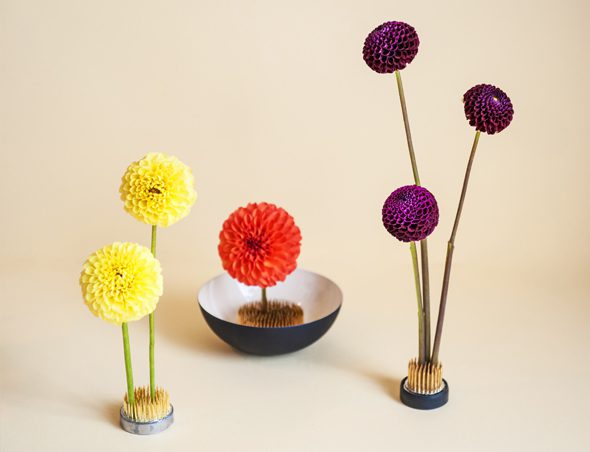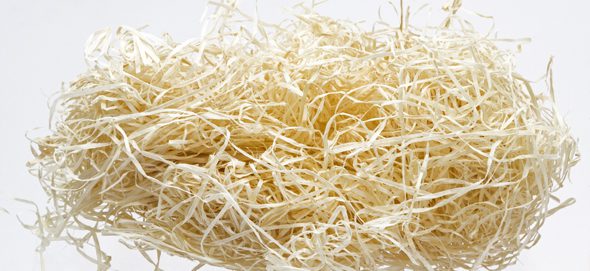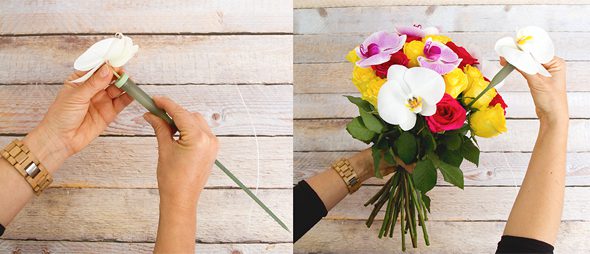
What are alternatives to floral foam?
Until the revolutionary invention of floral foam over 60 years ago, florists would use chicken wire, straw, and even newspapers to support flowers at the base of their arrangements. It was Vernon Smithers who invented OASIS® Floral Foam in the United States back in 1954. Smithers-Oasis® invented a green sponge like material shaped as a brick that holds water. The construction of the material allows flowers to be inserted and arranged easily and it quickly became the florist’s best friend. It made arranging flowers easier, allowed flowers to drink water for days and simplified transport of flower arrangements.
Unfortunately, wet floral foam is formaldehyde-based, is not biodegradable and will not break down in landfill. So the question being asked now is “what alternatives to Oasis® floral foam do I have”?
Prior to the invention of wet floral foam, florists and flower arrangers used flower frogs, clay or foliage as a base for floral arrangements and it seems that many of these floral foam alternatives are making a comeback.
So in today’s modern world, what can I use instead of floral foam as a more environmentally friendly alternative?
There are many wet floral foam alternatives that are more eco-friendly than Oasis® floral foam not only for floral arrangements but also for bouquets and larger flower structures. Many of the suggested eco-friendly mediums below work well when they are bound tightly with wire.
Here are just a few ideas:
1. Chicken Wire
Chicken wire has become one of the designer’s materials of choice and has been used for many years as an alternative to wet floral foam. It is easy to cut, manipulate and sculpt. The mesh holes provide an easy place to slot flowers and make arrangements. It can be wound around structures and arches to make a magnificent base for many types of arrangements. Many florists will roll the mesh into a ball and place this in a vase or a pot before pushing flowers through the variety of holes and making sure they reach the water source. Chicken wire is eco-friendly, re-usable and biodegradable via corrosion.

2. Flower Frogs
A time honoured Japanese flower art called Ikebana. This form of flower arranging uses a flower frog also known as a kenzan or stayput. A kenzan is basically a metal disc with pins that sits in the base of your vase. The flowers are then pressed onto the pins to create an arrangement. This process helps open the base of the flower stem allowing it to drink water easily. Kenzans can be secured in the base of the arrangement vessel with Sure Stik. They are easy to clean and reuse. Eco-friendly, re-usable and biodegradable via corrosion.

3. Gravel rocks and pebbles
Gravel rocks and pebbles tightly placed in a pot or vase can make a suitable base to either push flowers in and arrange. Pebbles can also be poured in and around a finished bouquet to stabilise the arrangement. Eco-friendly, re-usable, biodegradable.
4. Willow, rattan or pliable reeds
Just like chicken wire, you can create a mesh like structure to insert flowers using willow, rattan or pliable reeds. This structure can be in the shape of a wreath that can be placed and secured in the base of a vase or florist pot. Eco-friendly, re-usable, biodegradable.
5. Wood Wool
Wood wool that is commonly used for packing fruit, seafood and wine is shredded timber fibres. Clustered together it can form a firm base to insert flowers into. It can also be used inside plastic floral cages and shapes to create a brick effect. It has a certain level of water absorption as well. Eco-friendly, re-usable, compostable and biodegradable.

6. Straw
Similar to wood wool is straw or hay. Stray can be compacted to make a suitable base for flower arranging. Eco-friendly, re-usable, compostable and biodegradable.
7. Water vials
Water vials are small plastic tubes with a rubber cap that flowers can be inserted into. These are commonly used in the florist industry and are a great water source for flowers. These are used extensively when using chicken wire to decorate. Water vials are made of recyclable plastic.

8. Flower Foliage
Another alternative to Oasis foam can be flower foliage although this is associated with the possibilities of growing bacteria. Flower foliage is probably best for arrangements that do not need to last for days. Fill your pot or vase to the top with soft leaf foliage, compact gently then just push the stems through. The foliage will last for quite a few days in water.
9. Moss
Natural moss has been around for years as a favourite base medium for many styles of eco-green floral designing. It is dense, absorbs and holds water and is very easy to shape and use. Natural moss is used along with other wire work structures. Eco-friendly, re-usable, compostable and biodegradable.
10. Floral Clay
Floral clay is waterproof and is a plasticine or clay style of adhesive that is extremely sticky and will glue almost anything. It is waterproof and will hold most material together. It can be reused and is easy to separate once used. Re-usable and recyclable.
Many of the alternatives to floral foam mentioned are associated with florist techniques that have been taught during a time when floral foam did not exist. Now it’s time to learn these techniques again. Unfortunately the use of floral foam as a floral arrangement base cannot be avoided in many instances. Learning new sustainable floral mechanics to find the right balance between the use of floral foam and its alternatives is a first step towards an eco-friendly florist community.
The post What are alternatives to floral foam? appeared first on Koch & Co Blog.